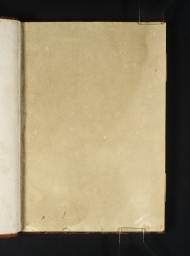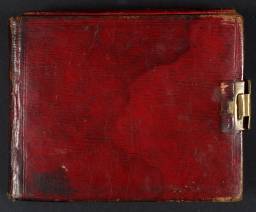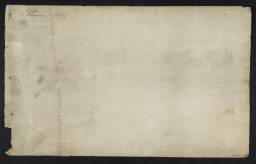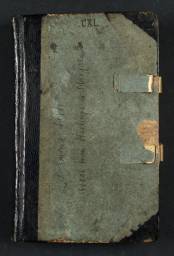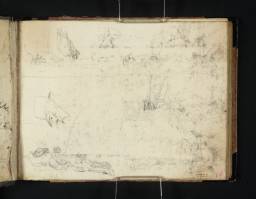Sketchbooks used in East Sussex, including Work for John Fuller and for Four Large Coloured Views in Sussex, Views in Sussex and Picturesque Views on the Southern Coast of England, c.1806–20
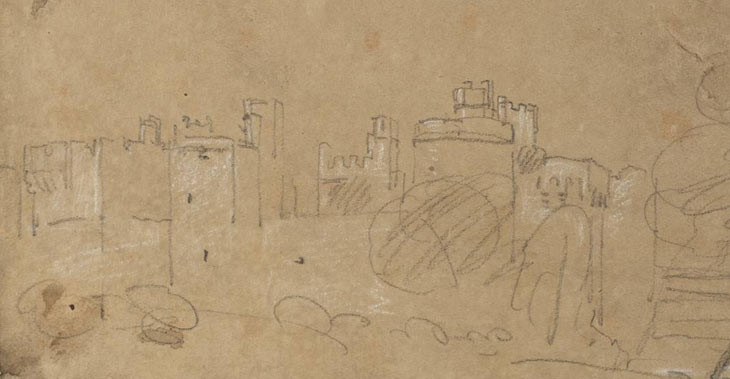
From the entry
These sketchbooks (some of which contain other material) are grouped for their views in Sussex, and relationships to watercolours and paintings made for John Fuller, for the four aquatints Large Coloured Views in Sussex, the engraved series Views in Sussex and its abortive sequel ‘Views at Hastings and its Vicinity’. The Herstmonceux and Pevensey and Sussex sketchbooks were probably the first to be used and are technically distinct, containing pages prepared with preliminary washes ranging from buff to grey or purple and drawn in pencil and chalk. Their dating of 1806–10 is provisional and based on the possibilities that Turner extended his visit to his friend William Frederick Wells at Knockholt, Kent in late summer 1806 to include a trip to East Sussex, but also that the books were used in 1810 following a commission from Fuller. At Knockholt in 1806, Turner and Wells discussed the idea of a collection of representative landscapes that became the Liber Studiorum and ...
Vale of Heathfield sketchbook circa 1809–16
D10206–D10319, D40863–D40866, D41535
Turner Bequest CXXXVII
D10206–D10319, D40863–D40866, D41535
Turner Bequest CXXXVII
Views in Sussex sketchbook circa 1810–17
D10320–D10324; D10326–D10342; D40296–D40298
Turner Bequest CXXXVIII
D10320–D10324; D10326–D10342; D40296–D40298
Turner Bequest CXXXVIII
Richmond Hill; Hastings to Margate sketchbook ?circa 1816–19
D10409–D10585; D40868; D41539
Turner Bequest CXL
D10409–D10585; D40868; D41539
Turner Bequest CXL
References
These sketchbooks (some of which contain other material) are grouped for their views in Sussex, and relationships to watercolours and paintings made for John Fuller, for the four aquatints Large Coloured Views in Sussex, the engraved series Views in Sussex and its abortive sequel ‘Views at Hastings and its Vicinity’.
The Herstmonceux and Pevensey and Sussex sketchbooks were probably the first to be used and are technically distinct, containing pages prepared with preliminary washes ranging from buff to grey or purple and drawn in pencil and chalk. Their dating of 1806–10 is provisional and based on the possibilities that Turner extended his visit to his friend William Frederick Wells at Knockholt, Kent in late summer 1806 to include a trip to East Sussex, but also that the books were used in 1810 following a commission from Fuller.
At Knockholt in 1806, Turner and Wells discussed the idea of a collection of representative landscapes that became the Liber Studiorum and perhaps Turner set off towards the Sussex coast in search of suitable material. At least one Liber subject, Martello Towers, near Bexhill, Sussex originates in a sketch in Herstmonceux and Pevensey (D05628; Turner Bequest XCI 11), and there may also be a link to the Liber plate of Pembury Mill from a sketch of a mill wheel (D05679; Turner Bequest XCI 62). Turner would have passed through Pembury if he took the direct road (now the A21) from Knockholt to Battle. Sussex contains the origin of two more Liber designs, Winchelsea, Sussex and The East Gate, Winchelsea (D05762, D05763; Turner Bequest XCII 43, 44) among a run of subjects along the coast between Hastings and Rye. Herstmonceux to Pevensey contains architectural and antiquarian subjects, Herstmonceux, Pevensey and Bodiam Castles and Battle Abbey which Turner painted for Fuller. Either Turner’s interest preceded Fuller’s or these drawings are directly connected with his commissions.
It seems that Turner’s work in East Sussex was underpinned by personal connections in the area, but they are still somewhat elusive or have been obscured by his more familiar work for the Earl of Egremont and visits to Petworth in the west of the county. Turner’s own longer title for Herstmonceux and Pevensey includes ‘G’, perhaps denoting Guestling near Hastings where Evelina, Turner’s supposed natural daughter by Sarah Danby, had been baptised in 1801, while the village is mentioned in the first of the two Hastings sketchbooks (Tate D07751; Turner Bequest CXI 99) at much the same time in 1810 as Sarah gave birth to another daughter, Georgiana. This might suggest that Turner had more than the professional business in the district occasioned by Fuller’s order for local views that spring.
Personal and professional affairs seem to have interacted here too, for after the death of his wife Mary in 1807, William Wells took a new partner, Susannah Thrale, who had when younger rejected advances or even a proposal from Fuller.1 Wells and Susannah never married (neither did Fuller) and Wells was known in the Thrale family by the pseudonym ‘Mr Ash Grove’ after his Knockholt cottage, where Susannah spent the rest of her life. Her mother Hester Thrale had disapproved of Fuller, to whom her eldest daughter Hester Maria was more attached than was Susannah, and now had to come to terms with Susannah’s relationship with Wells. Meanwhile Mrs Thrale’s family had not accepted her own second marriage to her daughters’ music teacher, Gabriel Piozzi.
Among the many links between the Thrale, Burney, Piozzi and Fuller families, a common thread is music, also beloved of Turner and the profession of John Danby, late husband of Turner’s companion Sarah. Evelina Danby was presumably named after the heroine of the novel Evelina (1778) by Fanny Burney, daughter of the musicologist and organist Dr Charles Burney, an admirer of John Danby.2 A sum of £4 4 mentioned in the Hastings sketchbook (inside front cover, D07594) probably represents most of the monthly allowance of £4 14 6 paid to Sarah by the Royal Society of Musicians, which Turner sometimes collected on her behalf;3 adjacent sums might be the fees of a doctor and midwife in attendance at Georgiana’s birth.
Whether these circumstances merely indicate the small world in which cultural figures then moved, or suggest that Turner and Fuller came to each other’s attention before 1810 via common interests and unconventional private lives is an open question. That spring Fuller, of Rosehill (now Brightling) Park, commissioned four watercolours and a painting, Rosehill Park (private collection),4 prompting Turner’s visit to East Sussex. Fuller was busy improving the house and park with the architect Robert Smirke and the landscape designer Humphry Repton. Besides Rosehill, Turner’s watercolours portrayed estates nearby, Ashburnham, Beauport and Battle Abbey.5 They were to be hired for reproduction, and Joseph Stadler’s aquatints, Four Large Coloured Views in Sussex, were published privately circa 1818 for presentation to Fuller’s friends and neighbours.
Fuller had since bought the original watercolours and commissioned more of local subjects in which he took an interest.6 In 1815 he agreed to support engravings of them by William Bernard Cooke, and in 1820 five were published as Views in Sussex, with a new frontispiece and letterpress by the artist Ramsay Richard Reinagle. The publisher should have been John Murray but he withdrew in 1819, irked by Cooke’s slow progress on the plates for the larger series of Picturesque Views on the Southern Coast of England, undertaken in 1811. Cooke took over the promotion of Views in Sussex himself and in 1820 issued a prospectus for further ‘Views at Hastings and its Vicinity,’ for which Turner made six or seven more drawings. Cooke announced ‘Fourteen engravings of the most choice Landscape and Marine scenery in the Rape of Hastings, displaying with Truth and Effect the grand character of this picturesque part of the coast’. Again, Cooke could not keep up or make the project pay, and the sequel was abandoned. These (and other) projects overlap in this group of sketchbooks.
The first books to certainly contain Fuller-related drawings are the Vale of Heathfield and the earlier Hastings, both of which were previously used elsewhere, the former in Cumbria in late summer 1809 and the second in Oxford just after Christmas that year. Hastings is as much a notebook as a sketchbook, containing notes, poetry and memoranda on matters professional and personal as well as sketches of Rosehill (D07623–D07625, D17689, D17695; Turner Bequest CXI 20a–22, 61, 65) and a number of Hastings. The town, beginning its transformation into a resort, was newly fashionable with artists following the recent success of watercolours of its fishing fleet and fishmarket by Thomas Heaphy and Joshua Cristall. Fuller bought Turner’s painting Fishmarket on the Sands (William Rockhill Nelson Gallery and Atkins Museum of Fine Arts, Kansas City, Missouri)7 from Turner’s Gallery in 1810, and it later acquired the additional title ‘Hastings’. However, despite superficial similarities, sketches of beach scenes in this Hastings book probably post-date the picture, which may not actually depict the town; Turner perhaps told Fuller that this was its subject in order to increase its appeal to his Sussex client.
The Vale of Heathfield book contains drawings used for four Fuller watercolours, both from the original and the later sets, suggesting that most of the groundwork for them was done in 1810. A likely exception is his drawing of the Obervatory designed for Fuller by Smirke (D10254–D10255; Turner Bequest CXXXVII 36a–37) since the building only seems to have been started in 1810 and finished in 1818 and there are other views in the second Hastings book which is watermarked 1815 (D10394–D10395; Turner Bequest CXXXIX 34a–35). Turner had revisited Rosehill to observe the alterations Smirke had since made to the house (D10390, D10392, D10393; Turner Bequest CXXXIX 32a, 33a, 34), for a new watercolour (British Museum, London).8 Vale of Heathfield contains a drawing of another seat, Eridge Castle (D10230–D10231; Turner Bequest CXXXVII 14a–15), the basis of a watercolour (Whitworth Art Gallery, Manchester)9 not known to have been owned by Fuller but similar in date and format to his and perhaps intended for his friend Lord Abergavenny, who owned the estate.
Fuller, his commissions and choice of subjects are discussed in further detail in the Introduction to the dismembered ‘sketchbook’ called Views in Sussex as this is the most productive of preliminary drawings including a more finished study for the picture of Rosehill Park (D10329; Turner Bequest CXXXVIII 10). As Finberg explained, the book probably originally contained additional West Country subjects that he grouped as a separate Somerset and North Devon sketchbook (see Tate D08945–D08946; D40294–D40295; D41531; Turner Bequest CXXVI 1–18). These drawings date from 1811 when Turner made his first tour to Dorset, Devon and Cornwall for Southern Coast. A similar overlap is to be found in Vale of Heathfield which includes drawings from the same West Country trip, and also from a longer stay at Plymouth and a survey of the Rivers Tamar and Tavy in 1813.
Turner’s work for Southern Coast and its proposed Hastings sequel accounts for Sussex and Kent subjects in the later sketchbooks grouped here. A sketch map inside the back cover of the later Hastings book (Tate D40834; Turner Bequest CXXXIX unnumbered) is annotated: ‘Win[chelsea] Rye Playden Appledore Lyd[d] Romney Dunge[ness] Limne [Lympne] Castle Dimchurch [Dymchurch] Hythe Saltwood Castle Sandgate Castle Folkestone Dover’. This terrain spans Cinque Ports and historic castles, the wastes of Romney Marsh and recent defensive infrastructure such as the Royal Military Canal and Military Road – contrasts or continuities that Turner always found suggestive. The ground is covered in drawings in the Richmond Hill; Hastings to Margate and Hastings books and pictured in the more easterly subjects for Southern Coast. Yet if Turner’s notes suggest a single tour it must be remembered that he continued working on Southern Coast into the mid 1820s and the watercolours based on his drawings are generally undated. Moreover, other projects intrude in these sketchbooks too. For example, Hastings ranges from a drawing of the town (D10371–D10372; Turner Bequest CXXXIX 22a–23) used for the watercolour Hastings from the Sea signed and dated 1818 (British Museum, London),10 intended for ‘Views at Hastings and its Vicinity’ to Yorkshire subjects probably from 1817 or 1818 made while staying at Farnley Hall.
Richmond Hill; Hastings to Margate is renamed in this catalogue to restore Turner’s own title and acknowledge its numerous drawings of Richmond and the Thames. These, like others in Hints River, are mainly connected with Turner’s painting England: Richmond Hill, on the Prince Regent’s Birthday (Tate N00502)11 exhibited at the Academy in 1819. However, they may reflect earlier events and probably contributed to later watercolours, as late indeed as Richmond Terrace, Surrey (Walker Art Gallery, Liverpool)12 of circa 1836 engraved for Picturesque Views in England and Wales. Hints River, in use till at least 1820, is included in this group largely because its Richmond subjects cannot be separated from those in Richmond Hill; Hastings to Margate. However, its position is also justified by the presence in a list of recent or current work (D10646; Turner Bequest CXLI 35a) of one of Fuller’s views of Battle Abbey, a view of Rye and the aforementioned Hastings from the Sea.
Acknowledgements
The author is grateful to Eric Shanes for his observations on this material, reviewed in connection with his forthcoming biography of Turner. Matthew Imms has catalogued the West Country subjects in Vale of Heathfield and given his usual help in tracking down Turner’s literary sources.
How to cite
David Blayney Brown, ‘Sketchbooks used in East Sussex, including Work for John Fuller and for Four Large Coloured Views in Sussex, Views in Sussex and Picturesque Views on the Southern Coast of England, c.1806–20’, August 2011, in David Blayney Brown (ed.), J.M.W. Turner: Sketchbooks, Drawings and Watercolours, Tate Research Publication, December 2012, https://www


